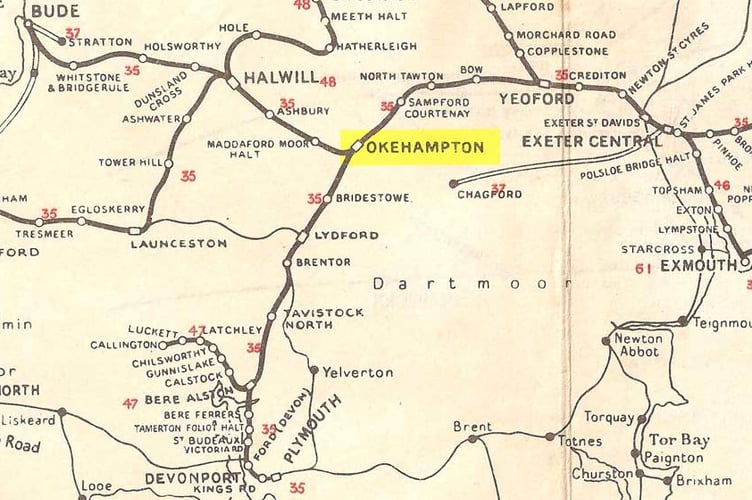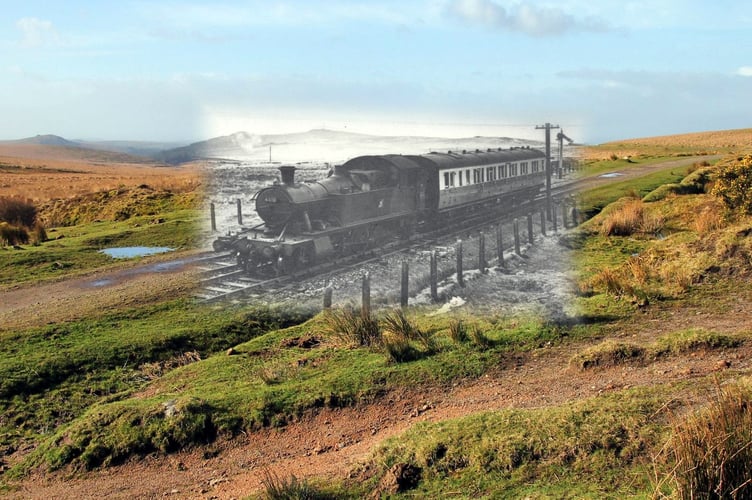The 2021 reopening of the Dartmoor Line (a stretch of track on the former ‘northern route’ mainline between Plymouth and Exeter) and the announcement of a second station for Okehampton have advanced the case for a full reopening of the northern route and a potential reintroduction of the former line between Okehampton and Bude, however advancements in modern technology have ensured that West Devon’s former railway network will never be fully restored.
At present, a section of the Tamar Valley line running through the Bere peninsula from Plymouth to Gunnislake and the Dartmoor Line are the only operational rail routes in the borough, however this could change with an upcoming announcement from the Department for Transport who received a strategic outline business case from Devon County Council in November last year to restore the rail route between Tavistock and Bere Alston (onto Plymouth).
Following the collapse of the Dawlish seawall onto the mainline coastal railway track in early February 2014, Network Rail considered reopening the Tavistock to Okehampton and Exeter section of the former northern route as an alternative route suited to both passengers and freight.
The line was listed in a January 2019 report by the Campaign for Better Transport as a ‘Priority 1’ candidate for reopening, this being defined as a scheme for which a clear case for restoration can be made.
The Department for Transport announced the £500m Restoring Your Railway Fund in January 2020 to enable opportunities to reinstate railway services with new stations. The fund was to be spent on developing proposals through feasibility studies, business cases and designs. Successful proposals received funding to develop their business case, which was then to be submitted to the Department for Transport in a bid for more substantial development funding. In November 2020, it was announced that a bid for the restoration of rail links to Okehampton had been successful and was the first project to be completed under the Restoring Your Railway initiative.
The Dartmoor Line (running between Okehampton and Crediton, onto Exeter), reopened for two-hourly passenger services on November 20 2021 and fared to huge success, with Network Rail reporting more than 50,000 journeys in the first twenty weeks – more than double the number predicted. Great Western Railway then introduced hourly services in May 2022, with 258,479 journeys made on the line in one year.
Devon County Councillor Andrea Davis, Cabinet Member for Climate Change, Environment and Transport and Chair of the Peninsula Rail Task Force said: ‘The reopening of Okehampton was a huge feather in the cap of everyone involved. Okehampton isn’t the largest community in the country so we were very fortunate. Part of the business case was that there was no other rail link there; now people can access the mainline. There are more opportunities for education, employment and of course it’s a beautiful line so more visitors can travel via a sustainable means of transport. It’s been a real injection for Okehampton and the whole area.’
On January 19 this year, it was announced that West Devon Borough Council had received £13,599,000 from the Levelling Up Fund, following a successful bid to develop a new railway station, integrated transport hub and car park on the eastern edge of Okehampton — to be named the West Devon Transport Hub.
Following these developments, residents of towns and villages with abandoned stations along the Dartmoor Line have called for these to be reinstated. Despite this enthusiasm, Manager of the Devon and Cornwall Rail Partnership Richard Burningham has cast doubt on the reopening of any former stations on this line, believing it to be an ‘unrealistic prospect’, citing the high cost involved in rebuilding or renovating station buildings and platforms in contrast to the small residential population they would serve. Although noting that ‘Network Rail weren’t against it’, Richard Westlake, vice-chair of OkeRail, also views reinstatement(s) as unlikely due to residents’ improved proximity to the easterly location of the newly announced Okehampton station and hourly services on the line being unable to meet their required timings due to the frequency with which they would be required to stop at the additional stations.
In October 2021, winners for the third and final round of bidding to the Restoring your Railway Fund were announced — one of which was a bid to reinstate the line and provision of new services between Tavistock and Plymouth, with Devon County Council securing £50,000 to develop the business case for this. The county council submitted the case to the Department for Transport in November 2022. The proposed scheme would reinstate approximately five miles of track between Tavistock and Bere Alston and deliver a new single platform station at Tavistock, constructed south of the A390 (Callington Road), which would serve around 21,000 local residents, with a forecast of 394,000 passengers a year. A spokesperson for Network Rail confirmed that the body was supporting Devon County Council with the submitted bid and said: ‘An announcement on successful funding bids is expected this summer.’
County councillor Angela Davis described the announcement as ‘imminent’ and said: ‘In the future, we would like to see the whole northern route re-opened and that is our primary objective with this part of Devon. If the Government come back and say they aren’t going to support it at this time, we will always look at other funding opportunities.’
The 1960s saw the infamous Beeching cuts – a series of major rail route closures and service alterations made as part of the restructuring of the nationalised railway system in Britain at the hands of then chair of the British Railways Board Dr Richard Beeching.
Richard Searight, Chair of TavyRail (formerly the Peninsula Rail Group) said: ‘Of all the 200-odd dissolutions Beeching performed, Tavistock was considered among the worst ten in that bracket. It was catastrophic in every way; such a failure of mind, planning and foresight. There is no if or but, we have to have our line back. We have a really good opportunity right now with the bid that’s currently with the Government – it’s a massive opportunity. If they say yes, it’s an important next step. If they say no, it’s putting it back by another decade probably, possibly more.’
The business case outlined the need for a new Tavistock station, as using the site of the former Tavistock North station at Kilworthy Park would prove difficult. Following the line’s closure in 1968, West Devon Borough Council’s offices and housing have since been built over the former track bed between the station and the viaduct. Although the station building itself remains, this has been sold off to private ownership. Heading south from Tavistock towards Bere Alston, the bridge over Callington Road would also need to be rebuilt. These complications aside, Jamie Hulland, Devon County Council’s Transport Strategy Manager confirmed last year, following the council’s receipt of £50,000 to develop the case to reinstate this stretch of track, more than 80% of land needed to restore the five mile route had already been acquired by the council, with the rest being negotiated.

The remaining stretch of track on the former northern route between Tavistock and Okehampton rears greater infrastructural difficulties. Heading towards Okehampton from the former Tavistock North station, buildings which form part of Mount Kelly school such as the housemaster’s property have been built over the old track. Further up the line, another dismantled bridge at the former Brentor station would have to be rebuilt with the station building here and at Bridestowe now in private ownership. Between Lydford and Okehampton the former railway line is now known as the Granite Way, a popular 11 mile cycling and walking route. Disagreements have arisen as to whether the route would need to be replaced elsewhere or if it could return to its former location with trains running alongside.
Cllr Colin Lee of North Tawton Town Council has argued the track ‘would need to be diverted’. He said: ‘Some of the bridges and embankments have been removed and cuttings filled in so a lot of expensive work would be required.’ Richard Burningham, Chair of the Devon and Cornwall Rail Partnership said: ‘There is no way you can just say goodbye to it without a proper replacement; there will need to be planning and consent for a new Granite Way’, further arguing that it would be unsafe for users of the cycle and footpath to be in a few metres proximity to passenger and freight trains passing at proposed speeds of up to 70mph.
Richard Searight of TavyRail however argues: ‘A lot would be invested in the cycle track. Trains would only pass by 20 seconds in an hour and new trains are almost silent. Of course it would be fenced and three-track wide over one track with plenty of space’. County councillor Andrea Davis has drawn comparison with the Avocet Line connecting Exeter and Exmouth which sees a cycle track running in parallel to the line stretching the length of the River Exe estuary.
A significant and recent cause for concern has been the Meldon Viaduct, (part of the Granite Way). Following the reopening of the Dartmoor Line, Network Rail Chair Sir Peter Hendy suggested that the structure required upgrading as it is currently in too poor a state to meet current standards. In an interview with the Okehampton Times in the November 25 2021 edition, Mr Hendy said: ‘You might wonder how much it would cost to rebuild it. It is a huge structure and it’s really not in the condition you’d want and that’s the issue’.
Mr Burningham of the Devon and Cornwall Rail Partnership agreed, saying: ‘Network Rail engineers would need to take another look at whether Meldon Viaduct could be reused by trains. The will and funding will only become available if there is a need for significant extra capacity for trains on the Dawlish route.’
TavyRail Chair Richard Searight said: ‘Meldon Viaduct is a very strong bridge that has taken 126 tonne mineral trains in the not too distant past. Modern trains are a quarter of the weight,’ suggesting a parallel bridge or a different route as alternatives to rebuilding the viaduct.
Accurate figures concerning timescale to see full restoration of the northern route and the amount of funding required continue to be determined. Different sources agree the cost to reinstate the stretch of track between Tavistock and Bere Alston would be in the region of £100 million. In November 2022, TavyRail estimated the cost as being closer to £92 million. In a July 2017 report entitled Plymouth and South West Devon: Plan for Infrastructure and Investment, compiled by Plymouth City Council, West Devon Borough Council, South Hams District Council and Devon County Council, page 17 suggests the figure as being £55 million, however this is now outdated following the more recent estimates and the continuing rise in construction costs. Should the Department for Transport green light this stretch of track, TavyRail estimate it would take four to five years to construct.
Costs for the stretch of track between Tavistock and Okehampton remain more indeterminate than the Tavistock to Bere Alston section. In 2014, Network Rail estimated the cost of a full double-track railway at £875 million, with a 66% contingency. TavyRail Chair Richard Searight, stressing the need for this to be a two-track main line, said: ‘The restoration of our entire northern route, all 42 miles of it, is equivalent to just two miles to HS2. That’s enough money to restore our entire infrastructure. It’s not expensive – it’s dirt cheap. The whole line could be around £900 million, depending on the condition of Meldon Viaduct.’ He estimated full restoration could take ten years. Devon and Cornwall Rail Partnership Manager Richard Burningham agreed that ten years would be a more likely figure, saying that five was ‘too conservative’.
MP for Torridge and West Devon Sir Geoffrey Cox QC KC said: ‘I have seen various figures ranging between half to three quarters of a billion pounds at current prices. I would expect the preparation and construction to take five to ten years.’ MP for Central Devon Mel Stride agreed that costs ‘would be significant’ as did borough councillor Lynn Daniel who said: ‘The cost of restoring the line has spiralled and unless there is strong government commitment to fund this project it will remain unachieved’.
The former Okehampton to Bude line, which closed on October 1 1966, was listed in the 2019 Campaign for Better Transport report as a ‘Priority 2’ for reopening, this defined as requiring further development to be taken forward. Campaign group Connect Bude has been actively campaigning for seven years to extend the line towards Bude via a Holsworthy Parkway station.
The former track has been built over more significantly than the northern route. A housing estate has since been built over Halwill diversion and a Waitrose and Partners supermarket now sits where Holsworthy’s former station was located, at the eastern end of the viaduct. Whilst the compulsory purchase of property is feasible, as demonstrated successfully in other areas of the UK, such as the Borders Railway from Edinburgh to Tweedbank in Scotland which required the relocation of entire housing estates, Cllr Colin Lee described the case for restoration of this line as ‘very doubtful’ due to the area being ‘sparsely populated’ and the expensive cost of any such building work.
Connect Bude submitted a bid to the Department for Transport for a slice of the Levelling Up Fund to put towards a business case to reopen this line in March 2021, however this was later rejected that October. In December 2021, Connect Bude Chair Richard Wolfenden-Brown stated that, whilst disappointed with the outcome, the work on this bid was a stepping-stone to a stronger one at a future date.
County councillor Andrea Davis said: ‘For the moment I know that this is just a pipe dream; I’m not saying it’s unachievable but I’m being realistic about the financial state of the country. It would be fantastic if this line reopened but it is very complicated to build a railway and we don’t own any land here, meaning purchase from multiple landowners would be required.’
The re-opening of both mainlines on the borough’s former network is supported by a wealth of county, borough and town councillors, local MPs, the Devon and Cornwall Rail Partnership, OkeRail and rail operator Great Western Railway, however not everyone is in favour of restoration of the borough’s former tracks. TavyRail Chair Richard Searight said: ‘It’s very few who oppose this – statistically less than 1% – although I have met a few of those objecting. There’s one gentleman who always speaks to me who has a garden which would be affected by reintroduction of the line.’ County councillor Andrea Davis said: ‘There is no ground swell of opposition. I understand the views of concerned residents who may not want rail services going by at the bottom of their gardens every hour. I’ve only ever had two people contact me saying they don’t want this to happen — both landowners. I allay fears and say there is always consultation. Nothing happens behind closed doors.’
Members of the Tavistock and Okehampton Reopening Scheme, a group made of former railway and engineering experts, have also said they recognise objections and that their aim is to listen to these and resolve them.
Two branch lines between Princetown and Yelverton and Lydford and Launceston on the former West Devon rail network however will never return. The Princetown Railway was a ten and a quarter mile single track branch line that ran between Yelverton and Princetown (on the Plymouth to Tavistock line) which closed on March 3 1956 (pre-Beeching cuts) due to a decrease in economic viability as road networks were being continually advanced and private vehicle ownership more widespread. Today the former line is utilised as a popular cycling and walking route between Princetown and Yelverton.

County councillor Andrea Davis agreed that to reintroduce this line would ‘never be viable’. Mr Burningham of the Devon and Cornwall Rail Partnership said: ‘When the railways were built in the 1800s the only alternative was the stagecoach or the horse and cart – we’re never going to go back to a day when these are the only alternatives.’
The same fate remains sealed for the Lydford to Launceston line, originally built as a broad-gauge line by the Launceston and South Devon Railway and opened in June 1865. Passenger traffic ceased in 1962, with goods traffic finishing in 1964.
In social media posts published on the Tavistock Times and Okehampton Times Facebook pages in May 2023 asking for residents of the borough to share their views on whether they would like to see the former network restored, the overwhelming majority of respondents stated were in favour of reintroduction of the full northern route, connecting Okehampton and Tavistock and Tavistock with Bere Alston, with some drawing reference to the success of the Dartmoor Line. Reasons for support from Tavistock residents included alleviating congestion on roads such as the A386 into Plymouth and enhancing connectivity to the mainline to allow for faster onward travel to destinations such as London. One resident suggested the return of the Princetown to Yelverton railway line in order to showcase steam trains. Only one respondent advanced an opinion against reintroduction of the former railway network, suggesting that rail services would be used by county line drug dealers and that lines would quickly become strewn with litter and graffiti. Residents of Okehampton and the surrounding areas, whilst in favour of restoration, also called for speedy completion of the new West Devon Transport Hub and for former stations at Sampford Courtenay and North Tawton to be reinstated along the Dartmoor Line.


-and-Sally-Ann-(visitor-experience-officer)-trying-ou.jpeg?width=209&height=140&crop=209:145,smart&quality=75)

Comments
This article has no comments yet. Be the first to leave a comment.